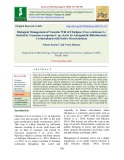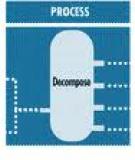
Ammonia volatilization
-
This work demonstrates the fabrication of a highly selective ammonia (NH3) gas sensor based on Graphene/SilvereSilver Oxide/Polypyyrole (Gr/AgeAg2O/PPy) nanocomposite. To archive this objective, a cost-effective, room temperature mediated solution-based synthesis of Gr/AgeAg2O/PPy nanocomposite was exploited as an efficient performance NH3 gas sensor through combining the exceptional electrical characteristics of Graphene and sensing abilities of AgeAg2O/PPy.
 11p
11p  meyerowitz
meyerowitz
 25-12-2021
25-12-2021
 2
2
 0
0
 Download
Download
-
Sixty one out of 200 isolates, isolated from chickpea rhizospheric soils, were found to be effective to control the mycelial proliferation of the test pathogen Fusarium oxysporum f. sp. ciceris, maximum being with Ps16b (45.7%) and Ps45 (87.3%) in dual culture plate and liquid broth assay. Growth inhibition of the phytopathogen was also recorded by diffusible and volatile antifungal metabolites produced by the isolates. All the isolates showed ammonia production, whereas only nine isolates were recorded for Hydrogen cyanide production.
 22p
22p  caygaocaolon4
caygaocaolon4
 01-04-2020
01-04-2020
 10
10
 1
1
 Download
Download
-
Urea is the most widely used nitrogen (N) fertilizer, with a projected increase in annual demand of 1.5% in the coming years. After its application to soil, urea undergoes hydrolysis via the urease enzyme, causing increases in the soil pH in the surrounding area of the granules and resulting in NH3 losses that average 16% of N applied worldwide and can reach 40% or more in hot and humid conditions. The use of urease inhibitors is an effective way to reduce NH3 losses.
 9p
9p  trinhthamhodang1
trinhthamhodang1
 14-11-2019
14-11-2019
 14
14
 1
1
 Download
Download
-
Some industrial facilities generate ordinary domestic sewage that can be treated by municipal facilities. Industries that generate waste water with high concentrations of conventional pollutants (e.g. oil and grease), toxic pollutants (e.g. heavy metals, volatile organic compounds) or other non conventional pollutants such as ammonia, need specialized treatment systems. Some of these facilities can install a pre-treatment system to remove the toxic components, and then send the partially-treated waste water to the municipal system.
 0p
0p  tainhacmienphi
tainhacmienphi
 19-02-2013
19-02-2013
 34
34
 2
2
 Download
Download
-
Secondary aerosol is produced by the oxidation of primary gases (sulphur dioxide, SO2, nitrogen oxides, NOx, and volatile organic compounds, VOCs,) to sulphuric and nitric acid, and organic vapours, followed by their gas-particle conversion [26, 77]. Finally, some of these acidic gases can be neutralised by reaction with ammonia gas or calcium carbonate (calcite) forming secondary aerosol (ammonium sulphate, ammonium nitrate, calcium sulphate, calcium nitrate).
 56p
56p  saimatkhauroi
saimatkhauroi
 01-02-2013
01-02-2013
 50
50
 7
7
 Download
Download
-
The principal pollutants from the transport sector responsible for adverse health effects include lead, various types of particulate matter, ozone (formed from atmospheric reactions of oxides of nitrogen [Nox] and volatile organic compounds [VOCs]), various toxic VOCs, nitrogen dioxide, carbon monoxide, ammonia and sulphur dioxide. However, the proportion of these various pollutants attributable to the transport sector varies significantly across different cities, as indicated by the table below.
 392p
392p  saimatkhauroi
saimatkhauroi
 01-02-2013
01-02-2013
 58
58
 5
5
 Download
Download
-
Microbial spoilage is manifested by a variety of sensory cues such as off-colours, off- odours, off- flavours, softening of vegetables and fruits, and slime. However, even before it becomes obvious, microbes have begun the process of breaking down food molecules for their own metabolic needs. Sugars and easily digested carbohydrates are used first, plant pectins are degraded. Then proteins are attacked, producing volatile compounds with characteristic smells such as ammonia, amines, and sulfides.
 10p
10p  ut_hai_can
ut_hai_can
 29-12-2012
29-12-2012
 61
61
 5
5
 Download
Download
-
Rumen fermentation is an exergonic process that converts feedstuffs to short-chain volatile fatty acids (VFA), methane, ammonia and occasionally lactic acid. Some of the free energy is used to drive microbial growth, but heat is also evolved. The efficiency of rumen microbial growth can have a profound effect on animal performance....
 34p
34p  lequanghoang15
lequanghoang15
 24-08-2010
24-08-2010
 74
74
 8
8
 Download
Download
CHỦ ĐỀ BẠN MUỐN TÌM




















